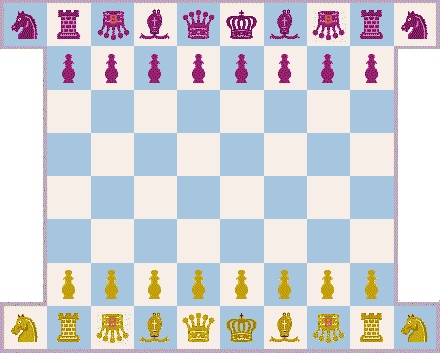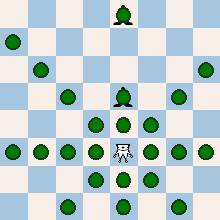

The Brigadier moves and captures like a Queen but can also capture an enemy if there is another piece (of either side) in between, and any interim squares are empty. Thus to capture it leaps over the intervening piece and lands on the enemy piece, like a cannonball (but it cannot jump without capturing). Otherwise, rules are the same as in standard chess, except for the possibility of pawn promotion to Brigadier. The Brigadier's value is Queen + light piece (Knight or Bishop).
The cannon movement derives from the Cannon in Chinese Chess (Xiangqi). However, in this game the cannon movement is also performed on the diagonals. The board type was conceived by Gustav III of Sweden (1746-92) for his own chess variant Gustav III's Chess. The Gustavian board makes it possible to place additional pieces on the board without substantially increasing the board size. It also brings the advantage that the Knight and Bishop remain equal in value. Brigadier Chess can also be played with Kwaggas instead of knights. Brigadier Chess was invented by undersigned, August 2006.
 The Brigadier moves and captures
like a queen, but can also jump
over the bishop on e5 and
capture the bishop on e8.
The Brigadier moves and captures
like a queen, but can also jump
over the bishop on e5 and
capture the bishop on e8.
There is also a variant where Scorpions take the place of the pawns. The Scorpion has the additional moves of a Knight, but only in two forward directions: east-north-east, and west-north-west. There are no additional capture moves. The Scorpion's value is half the value of a Knight or Bishop, that is, 1.5. This means that a light piece can be exchanged for two Scorpions, a possibility which often occurs. In the endgame it could become very dangerous, and its value often increases.
• You can download my free Brigadier Chess program here (updated 2007-02-25), but you must own the software Zillions of Games to be able to run it.
• You can play Brigadier Chess by e-mail, against a human opponent, here.
• Don't miss my other chess variants.
© M. Winther (August 2006).